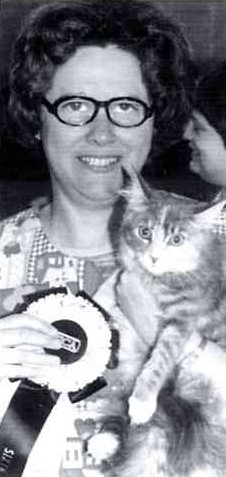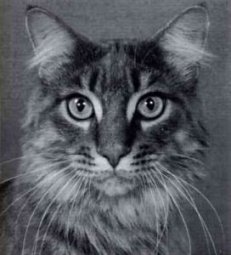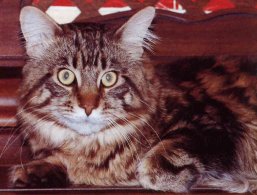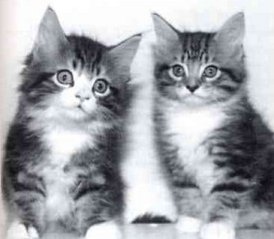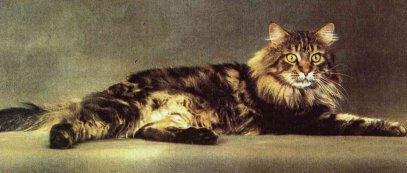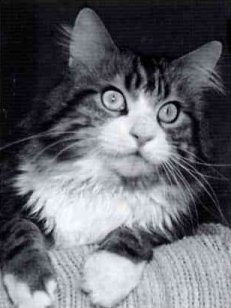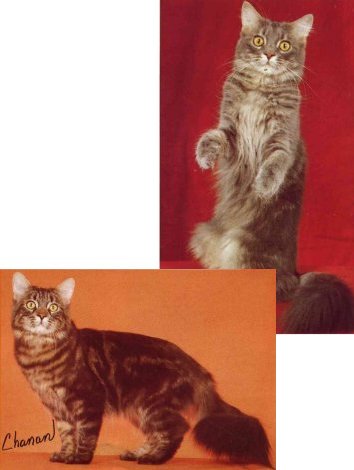| "This page was originally a part of the Maine Coon Heritage Site, a site that was first created in 1998 by Cynthia Bowen (Coontopia), Ulrika Olsson (Ylletrollets), Astrid Straver (Tricks and Tails) and Janet Marr (Furkats). It was then taken over by PawPeds, and it is now split up to fit better with the structure of PawPeds' website." |
 |
|
Ginny Molloy and CH |
Our latest look at a noted Maine Coon breeder takes us to the Bluegrass state of Kentucky and the home of Virginia and James Molloy.
| Cattery Name: | Charmalot | |
| Established: | 1977 | |
| First Maine Coon: | GRC Sundar Sarisvati of Charmalot |
Virginia and James Molloy and the Charmalot Maine Coons are well-known the world over, their breeding cattery having been established in 1977. Ginny chose the Maine Coon, she says, because she wanted a longhaired breed in a rainbow of colours - a desire which could have been encouraged by her first show cat, a longhaired calico household pet. While showing this girl, Ginny took the opportunity to search for her ideal breed and eventually decided upon a Maine Coon in the share of a brown MacTabby with white, Sundar Sarisvati of Charmalot, who later achieved Grand Champion status.
Two weeks before Sari arrived at her new home, Ginny met Connie Condit at a show and fell in love with her massive cats. Later, having got to know Connie and studied a few more cats and their pedigrees, Ginny felt privileged to be allowed to take home a wonderful Heidi Ho boy, (later TICA TGC and OS) Heidi Ho Richard III of Charmalot. Ginny says that her cattery is still today based on Richard, (who tragically died of FUS and uremic poisoning at the young age of four), together with Sarisvati and two other very important females, Charmalot Bluesette and Charmalot Lady Rebecca.
|
TGC, OS Heidi Ho Richard III of |
Of course, there were many other successes along the way. Richard was TICA's first ever Outstanding Sire, with his son, Walmet Daniel Coon of Cowtown becoming the second. -and these, together with the Outstanding Dam awards for females, of which she has bred several, Ginny finds far more satisfying than all the Champions, Grands and Supremes she can number from her breeding. SGC & OD Charmalot Bluebonnet of Cowtown once gave 6 Grand Champions in one litter, with most going on to Supreme! Both the first Blue Tabby Supreme and the first Brown Mac Supreme in TICA were bred at Charmalot and the full list of accolades is incredibly impressive, with around 50 Charmalot Grand Champions in 4 American associations, the first ever GC Maine Coon in CCA and several International Grand Champions in Europe. Ginny finds that her cats do best in TICA but she also has Grands in CFA, ACFA, CCA and some European organisations.
|
GCH Sundar Sarisvati |
She has at present 10 cats. Two are young adults, ready to be placed. Two are older adults to be retired. Then there's her new stud cat and five girls. All her cats live in the house, where there is a huge room each for boys and girls, with sliding glass doors, so that even the working boys feel like part of the household, and every home comfort for rest and play, even down to electronic air filters and humidifiers. All babies are reared in Ginny's own bedroom, coming out to live in the rest of the house at around three months.
|
Charmalot Big Mac, Blu |
Ginny attributes the success of her first couple of cats largely to luck, since she says that her first desire was to get the specific colours she liked. However, within a fairly short space of time, she became more selective and began to choose her own type, to which she has stuck with few modifications ever since. In her own words: "I loved brown tabby with white, and still do, but I found room in my heart for BLUE tabbies. Lynne Sherer (Calicoon) was, at the time, the only other breeder really seriously breeding and showing blues and the first well-known Charmalot blue litter, from my Ch The Maine Place Bastet of Charmalot, was sired by Lynne's Spavinaw Blu-Macks of Calicoon. That litter produced two DGCs, plus Ch & aD Charmalot Bluesette, on whom, together with Richard III, the well-known 'Charmalot Blues' were based." She lists six cats as being those without whom she could not have achieved all she has done. They are: SGC The Maine Place Wellington of Charmalot; his sister Ch The Maine Place Bastet, Bastet's daughter, OD & Ch Charmalot Bluesette; Wellington's daughter, Ch Charmalot Lady Rebecca; OS TGC Heidi Ho Richard III of Charmalot SGC Charmalot King Arthur Pendragon.
|
TICA DGC & CFA GC Charmalot |
In the beginning, she was mentored by Phyllis Voth of Sundar Maine Coons and later by Pat Hevenor of the Maine Place. Since then, Ginny has done some mentoring of her own, helping her proteges, Mary Schweiger of Cowtown, Gerry Walsh of Walmet, Vickie and Larry Fisher of Coonquest, Marlene Wacker of Mainedieval and most recently, Reva and Stuart Schneider of Dawncats, who are still working closely with her today. Her advice to would-be breeders centres on her own philosophy. She says new breeders should:
- Go to some shows and see a lot of Maine Coons and meet a lot of breeders.
- Purchase a showable alter at first, to learn with. Go along to the shows and develop your eye and decide what your picture of the perfect Maine Coon is. It will change as you go.
- Find a mentor who is ethical and honest and who will help you with advice and support.
- Take that person's advice and, once you are used to showing and working with your alter, look for a female breeding cat - not an entire male to begin with. Breed her and find out if you really like breeding.
- Go slow. Don't go out and buy 10 cats in the first two years. Learn what you're doing, first, and what constitutes a good Maine Coon. Decide where your breeding program is going to go and set specific rules.
- The golden rule should apply: treat others as you would be treated and you will be surprised how it will come back to you.
|
Two kittens out of |
If she had her time again, there are few things Ginny would change about the way she has operated her breeding program over the years. She admits to having made a few mistakes with new lines to mix with her own, which just didn't 'click' and had to be altered and placed as pets. But she is philosophical: "We all make mistakes in our choices and just have to take them out of our breeding programs." She says she would now choose to take more time to learn about diseases, setting up a cattery and caring for kittens BEFORE she got started - in her words, "It was a great learning experience but it would have been better to have known more."
|
SGC Charmalot King Arthur Pendragon, |
So what in particular does Ginny look for now in her kittens? "As for characteristics, I have now a little more extreme cats, but not by a lot. Definitely bigger, which I set out to do, and a little straighter noses, as they had bumps and breaks to a great extent in those days. Bigger ears now, also. But, today, you'll find my cats look a great deal like what I started with, at least in the first three years. I've refined them a lot, of course."
|
SGC Charmalot Monhegan |
Generally, Ginny says she doesn't go for fads and fashions. She still loves the old cats, but with the few modifications mentioned. Her priorities are still healthy cats with good temperaments, with easy breeding and kittening being some of the most important factors. Some of the modern cats are too extreme in their type for her taste, being too feral in their look and too far away from the cat we started with. Too many of them have insufficient muscle and bone to back up the long bodies and legs favoured by some breeders today which, she believes, may be a factor in the worrying condition of hip dysplasia. Too many do not have enough coat, yet ear tips so long and thick that Ginny believes they ruin the line of the ear. As she says: "We want eartips, but not something that makes their ears look like donkey ears. Now, I have some cats that are a bit extreme, but they still have sweet faces, they still have good boning and some decent coat, they still have the muscle and they are solid." But, for all that, she is still a firm believer that one can mix a more extreme cat with a more moderate mate and come up with something pretty spectacular in the resulting litter! One can even breed cats with quite serious flaws, she says, provided one knows that one's other cats do not have any of these flaws and can compensate for them. But she stresses that this should only be done if the good points outweigh the flaws very heavily and are an asset to the line.
|
SGC Charmalot Studz |
So we moved on to the subject of the real 'extremes' - the show cats.
Her favourite characteristics are, in order: health - to be well socialised with a good disposition - to have large eyes - large ears - good boning and density - females must have a feminine look, males must be large and handsome.
She reinforces her statement that she believes that the feral look does not fit the standard as well as the original sweet looking Maine Coon. When looking for potential show cats in her own litters, Ginny feels that 4-5 months is the optimum age to decide, although she has had a rare few which looked spectacular even at 6 weeks. Her lines, she says, grow in fits and starts and tend to be late developers; but of one thing she is quite sure - "If they're good young, they'll be spectacular older. They rarely fall apart, usually get better and better. I breed for certain characteristics, but do vary somewhat from cat to cat. I do get a certain look, though - you can usually tell a Charmalot cat by looking at it!"
|
top: The Maine Place Bastet of |
Ginny, in common with most of the breeders we speak to, feels that a cat does not have to be a show cat to breed the best kittens. In fact, many a top show cat will not reproduce its own potential at all - generally those show cats who were not consistent with the type usually produced by their parents. Since Ginny has a deep interest in pedigree research, she says she will generally look at the pedigree before the cat, aiming for the consistency of the line rather than the 'look' of the particular individual. She is an advocate of carefully controlled line-breeding but feels that it is necessary to introduce outcrosses often, to keep renewing the hybrid vigour of the breed. When asked about the validity of the continued use of unpedigreed foundation cats, her opinion is that we need additional lines in the breed but that there is too little we can do to control how these cats are used. She believes that the quality control is not consistent enough, as there is no one authority to make the decisions. She is also concerned that guidelines for the proper testing for undesirable genetic traits are impossible to enforce - as she points out, there are enough problems going almost unheeded in some fully pedigreed Maine Coons, without more coming in from unknown sources.
|
Charmalot Lady Melissandra, |
So what is Ginny's general philosophy these days and how does it differ from the way she felt in the beginning? Her comment is: "Breed only healthy and well-adjusted cats together. Keep only the same and make pets of everything which does not meet these rigid requirements. Good health and temperament are VERY important, indeed more important than whether a cat is show quality or not. They should also be easy to breed, easy to deliver kittens, good mothers. Once you get these, you choose the best ones and breed them together. Then you add occasional outcrosses, using the same requirements. Do not ever forget:
Health - Temperament - Size and type
"Then treat others in a fair and helpful way. Place your cats' welfare above honours, ego and money. If you do those things, you will be successful. If you're dishonest with people, you will soon be found out and your name will be mud!"
Ginny is proud of her philosophy. Well, shouldn't we all be?
© "Maine Coon International", issue 7, 1996.
Reprinted with permission.

